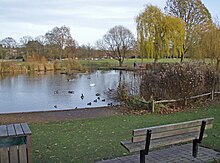Ham Common, London
Since the cessation of grazing in the 1930s, the eastern section has transitioned from acid grassland heath with gorse, bracken and bramble, to mixed oak woodland.
The local authority and volunteer groups manage the habitat, keeping paths and bridleways clear and removing invasive species such as Snowberry.
[7][8] Parts of Church Road, Ham Common are closed to traffic in spring to protect migrating toads to cross safely.
[13] The enclosure of the Park was one of several of Charles' unpopular acts that contributed to the unrest leading to the Civil War.
About ten years later, Cromwell's Army camped on Ham Common on 18 November 1647, after the Putney Debates.
The vestry records reveal typical recurring issues such as encroachment from adjacent land-owners, squatters (who might subsequently gain right of residence and add to the burden on the parish), itinerant groups, over-grazing, nuisance of geese, pigs rooting and blocking drains, turf damage from exercising horses and grazing of animals by non-local owners including, on one occasion, a flock of 200 sheep from Kingston!
In 1891 the Dysarts erected notices on the common warning that those removing "gravel, turf, etc without having obtained the license of the Lords of the Manor" would be liable for prosecution.
[18][19] In December 1896, a local enquiry was established with the Board of Agriculture to consider a scheme for the lammas lands under the Metropolitan Commons Acts.
The latter bill contained the same proposals but more concessions than its predecessor and focused more on the preservation of the view from Richmond Hill from urban development.
The Board of Conservators, established the preceding year, was dissolved in favour of Ham Urban District as well.
The Dysart Trustees also gave £3000 to be invested for the upkeep of the common and any residual money to go to almhouses or other local charitable purposes.
[23] Whilst the act achieved its objectives, part of the inclusive settlement with the Dysart Trustees extinguished the remaining lammas rights in Ham, thereby liberating the agricultural land for development.
A horse track crosses the common, linking Richmond Park to the river via the avenue to Ham House.


